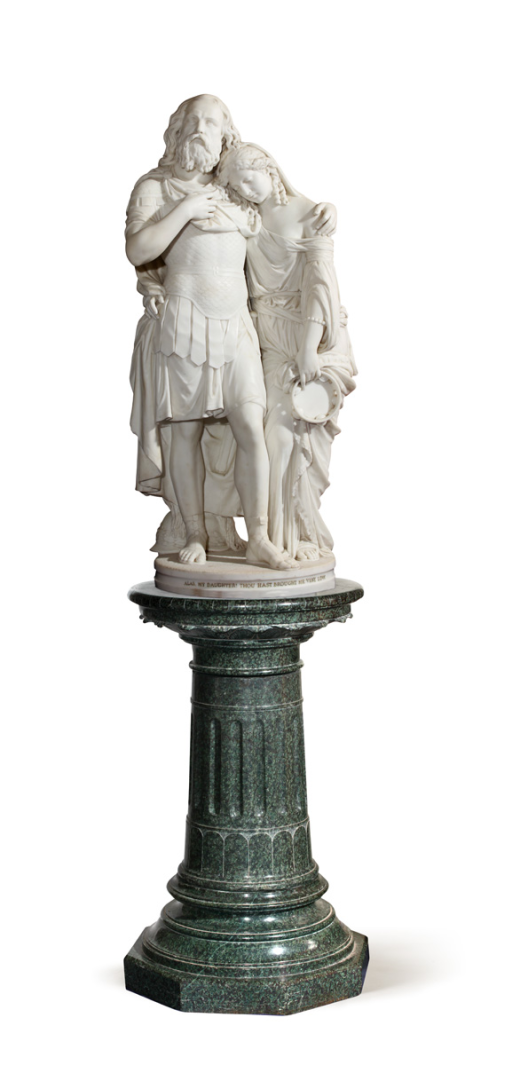Catalogue Notes
Born in Italy, Giovanni Giuseppe Fontana (circa 1821-1893) worked in England from 1850 onwards, primarily from his Chelsea studio in London. The talented neoclassical sculptor - whose admirers included Queen Victoria - primarily used Carrara marble and was first introduced to the Australian colonies with his inclusion in the Sydney International Exhibition, 1879-1880. (1) Exhibited in the British Court within the newly built Garden Palace - then located in the Botanic Gardens - he presented nine marble sculptures, notably La Sonnambula (1878, Art Gallery of New South Wales, Sydney). Not long after his presentation, Fontana returned to London in 1880 to begin work on his commission issued by New South Wales Premier and patron of the arts, Sir Henry Parkes GCMG (1815-1896) for three large public works for the Colonial Secretary's Building (now the general Post Office) façade located in Martin Place. Working from photographs of Queen Victoria, the two-meter-tall public commission took three years to sculpt in his Chelsea studio, prompting an important visit in 1883 by the then Prince of Wales, Albert Edward VII to approve its completion and commend upon its quality. (2) Fontana and his compositions arrived in Sydney on the H.M.S Cuzco steamship on 10 April 1884 to supervise the installation of these major public commissions. (3) He was accompanied by additional marble sculptures, including the present Jephthah and His Daughter (circa 1883). Eager to display his work across the colony, this sculpture would be first exhibited alongside three other pieces by Fontana at the Botanic Gardens Museum in June 1884, (4) prior to a selling exhibition at the Farmer & Company showroom in Pitt Street. (5) The same piece appeared six years later at the Tasmanian International Exhibition 1891-1892 in Launceston. (6) A larger example of Jephthah and His Daughter, without the biblical inscription is located in the Walker Art Center, Liverpool. The sculpture depicts the Old Testament fable (Judges 11-12) of the warrior Jephthah the Gileadite and the tragic results of his impetuous vow to God. In return for a victory against the warring Ammonites, Jephthah promised to God that whoever 'cometh forth of the doors of my house to meet me, when I return … I will sacrifice it …' Upon his victorious return home and much to his dismay, he was greeted by his only child and daughter at the door. The anguishing Jephthah would scream: 'Alas my daughter! Thou hast brought me very low, I have made a vow to the Lord that I cannot break.' (Judges 11:31-39) Whereas the allegory describes the warrior violently tearing off his garments, Fontana substitutes the dramatic scene with two self-composed figures, affording the artist more formal control to sensitively sculpt their drapery and anatomy. Clutching at her timbrel and head softly rested on his shoulder, the sculpture confidently conveys the daughter's tragically content and stoical response: 'My father,' she replied, 'you have given your word to the Lord. Do to me just as you promised, now that the Lord has avenged you of your enemies.' (Judges 11:31-39) Tim Marvin (1) Sydney International Exhibition, 1879: Official Catalogue of the Art Gallery: New South Wales, Great Britain, Austria, France, Germany, Belgium, T. Richards, Govt. Printer, Sydney, 1879, p. 7 (2) 'Late Cablegrams', The Maitland Mercury and Hunter River General Advertiser, New South Wales, 3 November 1883, p. 14 (3) 'Shipping', The Sydney Morning Herald, Sydney, 11 April 1884, p. 4 (4) The Sydney Morning Herald, Sydney, 16 August 1884, p. 5 (5) 'Signor Fontana's Statuettes', The Evening News, Sydney, 18 August 1884, p. 3 (6) Official Catalogue of the Exhibits: Tasmanian Exhibition, Launceston, 1891-1892: Opened November 25th, 1891, James Brickhill, Launceston, 1891, p. 56. Although the work is not listed in the catalogue, a newspaper review describes the piece on display. See 'The Fine Arts', The Daily Telegraph, Launceston, 24 December 1891, p. 2





